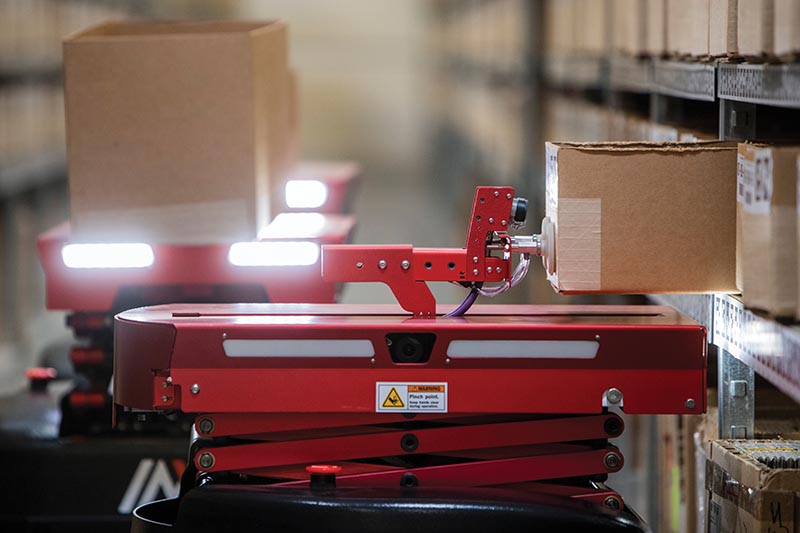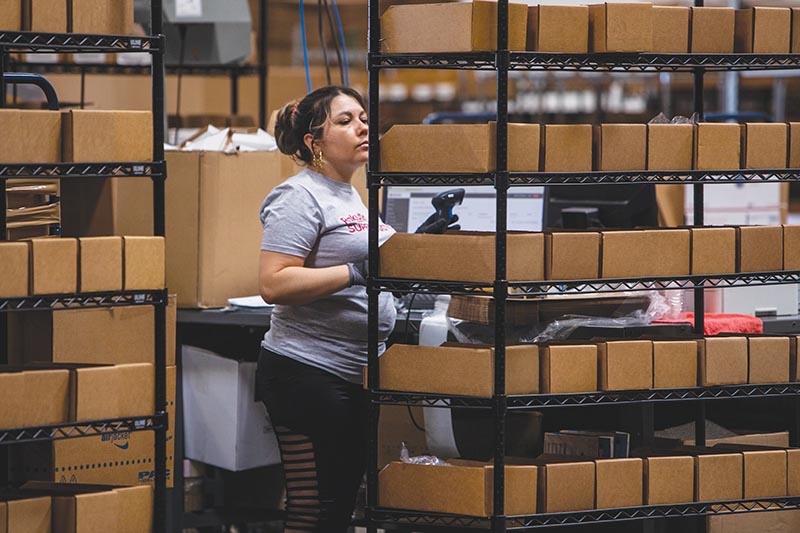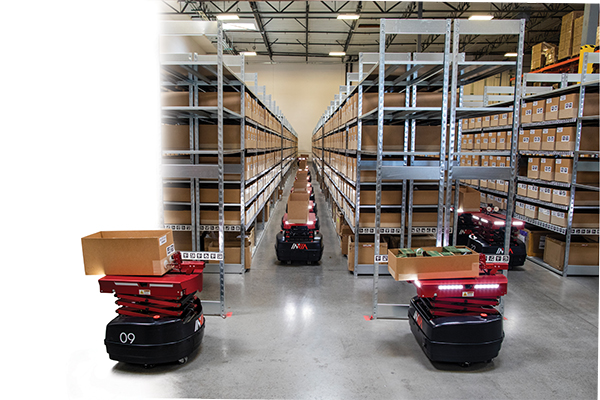In today’s e-commerce world, fulfillment has as much to do with the design of the network as it does with what happens inside the facilities located along that network. In the best of circumstances, the two work hand-in-hand. What’s more, in a fast-changing industry, what you’re doing today is not nearly as important as positioning your company for where you need to be five years from now.
In essence, that’s the strategy behind the redesign of Rakuten Super Logistics’ e-commerce fulfillment network here in the United States, as well as the adoption of autonomous mobile robots (inVia Robotics, inviarobotics.com) as the fulfillment engine for its strategically located DCs.
“Amazon has done a wonderful job of creating a need that didn’t exist before and convincing people they can’t wait for the product they just ordered,” says Mike Manzione, CEO of RSL, a provider of e-commerce order fulfillment and delivery services to small and mid-sized companies.
While Manzione notes that less than 20% of the client base is asking for same- and next-day delivery now, “we can see where the market is going, and we’re anticipating where we will need to be in the next five years.” He adds, “with the robots, we can continue to receive and pick orders continuously for delivery the next day.”
To that end, RSL is in the process of building out a different kind of network, with a different style of fulfillment center. At present, RSL is operating a network of 12 strategically located distribution centers across the country with plans to go live with four more in the next six months. Other facilities and locations are on the drawing board. Many of those will be located in or near large urban population centers; for instance, RSL currently operates two DCs in Las Vegas, two in Reno, one in Salt Lake City and one in Los Angeles to service the West Coast.
Instead of building 300,000- to 500,000-square-foot DCs, Rakuten Super Logistics has developed a model for order fulfillment in 40,000- to 70,000-square-foot facilities that can be quickly rolled out in a new location, and with technology and processes that are familiar to any RSL manager or associate moving from a distribution center in Las Vegas to one in Scranton, Pa. The idea is similar to the system McDonald’s perfected for building cookie cutter stores around the world.
Mobile robots are at the heart of the design. Currently, they are the engine behind picking and, in the near future, the robots will also manage replenishment in the pick modules. “Our facilities were designed to be
very efficient,” says Manzione. “However, we began to realize that even though they met our current needs, the labor pool continues to shrink, and the workload continues to go up while there is the pressure to keep prices low. We asked: What could we do to continue to mitigate prices and still give better service?”
Like designing a network to get ahead of where the market is going, Manzione says RSL added robots “for what we’re going to need in the future. The customer today isn’t demanding them in every city, but it’s coming. It’s better to be ahead of the trends than trying to catch up.”
Robotics-as-a-service
Robotics-as-a-service, or RaaS, is an increasingly common model in both the autonomous mobile robotic space that Rakuten Super Logistics has deployed, and piece picking robots from companies like RightHand Robotics and Kindred AI.
In RSL’s example, the company pays a per piece handled fee to inVia Robotics, not unlike what a 3PL like RLS might charge its clients. The advantage of this model, in the view of RSL’s CEO Mike Manzione, is that he is only paying for the work performed by the robot. “If I have a human coming to work and my business volume is low, I probably send that person home. If I own the robot and the work isn’t there, my costs go up. With RaaS, I’m not paying for the robot to sit there,” Manzione says.
He adds that inVia has done a very effective job of right sizing the fleet to meet RSL’s demand. “When we were rolling out the robots we always had 10% to 15% more available robotic capacity than we thought we needed to manage peak volumes,” he says. Now that both RSL and inVia have a history, he adds that the robots are always in use.

Building e-comm capability
Rakuten Super Logistics is part of the Rakuten Group. The parent company was founded in 1997 as Rakuten Ichiba, self-described as “a B2B2C marketplace, launch(ed) with just six employees, one server, 13 merchants and the strong desire to empower merchants that are small, regional or perhaps unfamiliar with computers and the Internet.”
U.S. consumers might know Rakuten best for its acquisitions of Buy.com and Ebates, which both now operate under the Rakuten name. However, with nearly $90 billion in e-commerce revenue in 2018, Rakuten is the largest e-commerce company in Japan and the third-largest e-commerce marketplace company worldwide. It is a global e-business powerhouse providing “a variety of consumer and business-focused services including e-commerce, e-reading, travel, banking, securities, credit card, e-money, portal and media, online marketing and professional sports.”
Rakuten currently has operations throughout Asia, Western Europe and the Americas. Rakuten began order fulfillment and delivery services to Rakuten Ichiba merchants in August 2012, followed by the acquisition of the French 3PL Alpha Direct Services in November 2012. The next year, 2013, Rakuten acquired the Webgistix Corp., a then 12-year-old company founded in Olean, N.Y., to provide a Cloud-based suite of e-commerce solutions for order fulfillment, freight management and shipment optimization.
At the time of the acquisition, Webgistix had built a network capable of reaching 98% of the United States in two days with ground shipping. By 2016, RSL could see that the existing network and warehouse design
needed to be tweaked to meet the demands of a changing e-commerce landscape. “Back then, we were in New York State, Atlanta, Las Vegas, Reno and Austin,” notes Manzione. “If you put your product in a certain number of facilities, you could ship by ground to most of the country in two days or less.”
What’s more, the original warehouse design, which featured relatively small distribution centers, conventional pick to cart, with some automation to get goods from packing to shipping, was created to operate in a small footprint, go live quickly and get a quick ROI. Variations in how one facility might operate compared to another were dictated by the products being handled.
“We developed a common design so that the flow of product and people in the warehouse could match each other. Size was determined by what we needed to leverage a certain number of SKUs,” he says. “Most of the time, we could do that in 40,000 to 70,000 square feet depending on the pattern of the network.”
But three years ago, Manzione says that RSL realized it needed new capabilities to keep up with coming changes in the market. “We’re trying to address the mind of the consumer,” he notes, adding that “the fulfillment business is not that sophisticated, to be kind. Pick, pack and ship has been around for decades. What’s new is anticipating the future: We needed to figure out where we’re going to be in five years.”
The first part of that process was rethinking the network around one-day and even same-day delivery by getting facilities closer to the consumer, even if most of the customer base was not asking for that now. RSL could then also offer first mile and final mile delivery services. That led to a facility in Scranton, Pa., followed by other strategic locations, including same-day delivery services in Salt Lake City and Los Angeles. By the end of 2019, the network will have expanded from five or six facilities a few years ago to 16 with more on the drawing board.
The next part was rethinking fulfillment processes with the addition of robotics. “We didn’t need inVia when we began working with them a few years ago,” Manzione says. “But robotics is where we need to be in the future to service our clients.”
A new model
Autonomous mobile robots not only represented a new order fulfillment model for RSL, but the solution it chose takes a different approach to the problem than some of the other mobile robotic solutions in the market. Think of it as bringing the mountain to Mohammed as opposed to sending Mohammed to the mountain. The most common approach today is to position an order selector or selectors in a pick zone that might otherwise be serviced by a traditional pick-to-cart methodology. Mobile robots receive orders from a warehouse management system (WMS) and, loaded with an empty tote, go to the spot where the first required item is stored.
An associate then walks a short distance to that spot and picks the required items to the tote. Once the order selector confirms the pick, the robot travels to the next pick location until the order is complete and then delivers the tote to packing. Softwareis key: Different robot manufacturers use different schemes to get the right number of robots to the right locations to maximize efficiency.
In the solution used by RSL, software is still key to determining the most efficient travel paths and the right number of robots to meet demand. However, the order selector is stationary at a goods-to-person pick location. The robots, in turn, work the pick modules, automatically retrieving bins from storage locations, and do all of the travel. Each robot has a scissor lift that allows it to retrieve bins up and down the height of the storage modules.
When the robot delivers a bin to a goods-toperson workstation, the order selector is system directed to pick and put items to locations on a rack. When all of the items for all of the bins on the rack have been picked, the rack is rolled over to a pack location. Meanwhile, when all of the items from a bin required for orders have been picked, the robot returns the bin to a storage location. In the future, RSL plans to use the robots for replenishment in addition to picking.
According to Manzione, RSL did investigate alternative automated materials handling technologies being used in e-commerce fulfillment as well as other approaches to mobile robotics. With regard to the former, RSL couldn’t justify the cost of conventional automation, such as a shuttle system, in its smaller footprint facilities. With regard to the latter, Manzione was sold on two things.
One was the cultural fit between RSL and its robotics supplier. “Sitting across the table from them, we felt they understood our operations and our needs,” he says. The other was the robotics-as-a-service model. “Robotics-as-a-service allows us to scale up or down, based on volume, without having to call a temp service to add people right away,” he says. “And, with the variability of volume in e-commerce, you’re constantly scaling up and down.”

Making the switch
The transition to robots took roughly a year. RSL began with one client in one of the two Las Vegas facilities that had relatively low volume. “The first thing we hadto do was integrate the robot management system with our proprietary WMS, since the robots receive instructions from the WMS,” Manzione says. The integration had to be complete before turning the robots on.
The next step was to modify warehouse shelving to work with the right size boxes for the robots. “It’s onething if you’re always selling the same products, but ours can vary,” Manzione says. “The more we worked with the robots, we figured out how to scale them to meet our needs.” A crucial period during the learning curve was the peak holiday season, when volume typically spikes by a factor of eight. During those six to eight weeks, a representative from the robotics company was on site.
“Peak was a real test because we ran multiple shifts, we were utilizing seasonal employees at higher volumes, we had more split orders and we were bringing in new SKUs at a higher rate than normal,” Manzione says. By the end of peak, RSL had run through almost every scenario of what could go wrong and had added every client in that facility to robots.
The most important lessons learned: Once associates realized that robots were there to improve their jobs and not replace them, there was excitement about working with them; and, the robots did not make mistakes. “If the robot makes a mistake, it was caused by a mistake made by a human upstream, and wehad to figure out how to prevent it from happening again,” Manzione says. Today, robots handle about 60% of the order fulfillment work across the network, although it varies by the products being handled in the different facilities. In some, it may be as high as 90% of the work and in others as low as 30%.
Typically, the limiting factor is the size and weight of the product. But, as Manzione said earlier, this isn’t so much about what RSL needs today, but where it’s going. “We see a time coming when receiving and packing will operate seven days a week, 24 hours a day,” he says. “The customer isn’t demanding that today in every city in the U.S., but it’s coming. You can’t add capability after the fact.”
About the Author
Follow Robotics 24/7 on Linkedin
About the Author
Follow Robotics 24/7 on Linkedin
Article topics
Email Sign Up
















